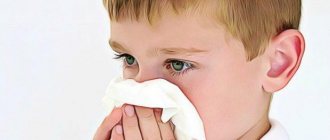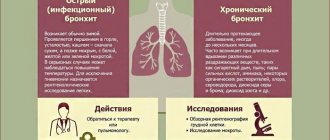Causes of cough
Cough occurs not only under the influence of a viral infection. The reasons for its occurrence may be different.
Non-infectious pathogens
Non-infectious causes can cause muscle spasms in the child’s nasopharynx and cause a severe cough:
High temperature of food consumed causes cough
- Entry of small foreign bodies into the respiratory tract (fluff, pieces of food, etc.).
- Allergic reaction to various substances inhaled in the air (washing powder, tobacco smoke, pollen).
- A sharp decrease in inhaled air, creating a temperature difference from high to low.
- High temperature of food consumed.
- Heart, lung or kidney disease.
- Chest injuries.
In these conditions, there may be no increase in temperature.
Infectious agents
The causes of a severe cough with fever can be life-threatening diseases of a viral or bacterial origin.
Whooping cough is a disease caused by bacteria, accompanied by a severe barking cough with fever. Children get sick more often, adults rarely. When a child has whooping cough, the mucous membranes of the respiratory tract are affected. Toxins released by bacteria affect the respiratory center, the walls of blood vessels, and impair the functioning of the heart and brain.
Measles is caused by viruses that affect the mucous membranes of the nasopharynx and upper respiratory tract. Children are mainly susceptible to infection. The disease is dangerous due to complications in the form of pneumonia, tracheobronchitis, characterized by a strong cough in a child with a temperature of up to 40°.
Pneumonia is an inflammation of the lower respiratory tract, in most cases of infectious origin. Almost always accompanied by a cough with fever. In children, as in adults, pneumonia occurs as a complication after a viral infection.
With bronchitis - inflammation of the bronchi caused by a viral or bacterial infection, a cough always occurs, but in some cases without fever.
Pleurisy is inflammation of the pleural layers lining the pleural cavity. The disease causes a severe cough with fever.
Inflammation of the mucous membranes of the larynx, most often of viral origin - laryngitis - is characterized by the appearance in a child of frequent coughing attacks against a background of high fever.
Diseases that cause coughing in a child with a fever are life-threatening. Therefore, the appearance of such symptoms should alert adults and prompt them to seek qualified help. Each case requires accurate diagnosis and timely special treatment.
Types of cough
Dry, paroxysmal cough, which is often disturbing at night, a possible manifestation of allergies (see How to recognize an allergic cough in a child) or asthma. When you inhale, dust particles, viruses, gases, bacteria and toxins are passively introduced into the respiratory system.
The mucus on the surface of the throat and blood vessels helps to trap them, and the cough reflex pushes the clogged secretions out of the respiratory tract. Taking medications that suppress natural function only makes the situation worse.
By productivity
- When only the upper respiratory tract is involved, the cough is dry, paroxysmal, without coughing up sputum (unproductive). The throat, larynx and trachea are affected.
- When infection and inflammation spread to the lower section (bronchi), sputum is released when coughing.
Frequent coughing causes a sore throat
If coughing is rare, there is no need to show concern, but if a child has difficulty coping with a convulsive cough that prevents him from inhaling a portion of air and leads to redness of the face, there is a reason to urgently visit a pediatrician.
Parents should pay attention to the symptoms that will help the doctor make a diagnosis:
- temperature;
- snot;
- general well-being;
- chair;
- skin rashes.
With the flow
An acute severe cough and high temperature in a child appears as a reaction to the invasion of a virus or microbes.
| Disease | Symptoms | Diagnostics |
| Respiratory tract infection. | Swelling of the mucous membrane and nasal discharge, redness of the throat, dry cough. | Examination by a pediatrician. |
| Croup | Difficulty breathing, barking cough (more attacks at night), wheezing, swelling of the laryngeal mucosa. | Examination by a pediatrician, chest x-ray required. |
| Bronchiolitis. Mainly in children under 2 years of age. | Runny nose, cough, fever, loss of appetite, anxiety, increased breathing, whistling when inhaling, blue lips, bloating due to expansion of the lungs. Secondary pneumonia is possible on day 2 | Examination and detailed questioning of the mother, x-ray and blood test (increased ESR and increased leukocytes). |
| Tracheitis (on its own or against the background of laryngitis, pharyngitis, rhinitis). | First a dry, then a wet, strong cough and a temperature of 38 in the child. Chest pain, lethargy, swollen lymph nodes, sore throat. | Examination by a doctor, listening to tones with a phonendoscope, taking an anamnesis. X-ray, blood test, throat swab. |
| Exposure to toxins in the respiratory tract. | Cough as a reaction to an irritant (dust, tobacco smoke, vapors of substances). | Examination by a pediatrician. |
| Epiglottitis (inflammation of the surrounding tissues of the epiglottis). | Develops after an upper respiratory tract infection, swelling of the tissues of the epiglottis, difficulty breathing, severe cough in a child with fever, anxiety, weakness, pain when swallowing, drooling, blue lips. | X-ray of the neck (lateral projection), examination with a fibrolaryngoscope. |
| Foreign body | Choking and persistent cough | Examination by a doctor, x-ray, bronchoscopy. |
| Pneumonia | In case of viral infection: coughing attacks, shortness of breath, fever, body aches. With bacterial infection: chest pain, fever, wheezing, decreased breathing. | Doctor's examination, x-ray. |
During the cold period, it is easier to catch a cold.
Chronic course, in which the cough is constant:
- Asthma. The child suffers from suffocation and bouts of prolonged coughing. Symptoms intensify with excitement, stress, exposure to allergens and changes in weather conditions.
- Pneumonia caused by mycoplasmas or chlamydia. Pain in the body and throat, loss of strength, wheezing when breathing.
- Cystic fibrosis. Frequent pneumonia, sinusitis, cyanosis of nails, developmental delay.
- Foreign body. Repeated cough, possible fever.
- Gastroesophageal reflux. Heartburn, cough, belching, hoarseness.
- Whooping cough. Paroxysmal severe cough and temperature of 37, suffocation, runny nose, vomiting after an attack (see Cough with vomiting: causes and methods of elimination).
- Tuberculosis. Sluggish symptoms include weakness, weight loss, fever, and sweating.
A child who has a runny nose, a temperature of 37 and a severe cough probably has a cold. But parents need to monitor his condition; if the thermometer reading reaches 39, the baby becomes weak and tries to breathe more often—pneumonia is suspected. Contact your doctor immediately.
Give your child bed rest if they feel unwell.
Cough classification
Cough is classified:
- by time of appearance (night, morning, spring);
- by the characteristic sound of inhalation and exhalation (whistling, sonorous, silent);
- by the presence of discharge (dry, wet);
- by duration (protracted, paroxysmal).
At home, coughs are distinguished by time, duration and amount of discharge:
- Wet when phlegm is present.
- Dry: there is little or thick sputum and coughing up is difficult.
- Night or morning. When going to bed, when the child assumes a horizontal position, a prolonged coughing attack may begin.
- Paroxysmal, beginning and lasting periodically throughout the day or night.
- Constant - continuous coughing.
Only a specialist can give a more precise definition of the type of cough.
Cough with ARVI
In the off-season, children under 3 years of age are more likely to suffer from acute respiratory viral infection (ARVI) than other age categories. The disease begins with typical symptoms:
- Muscle aches.
- Headache.
- Increase in temperature, sometimes up to 38–39°C.
- Nasal congestion and runny discharge.
- Dry cough.
With such a clinical picture, symptomatic treatment is prescribed: antipyretics, antiviral drugs, plenty of warm drinks and antihistamines. To relieve coughing attacks in a child with a fever, mucolytic medications are prescribed to help liquefy and remove mucous sputum. If the child is under 4 years old, all products are given in the form of syrup.
Breast preparations, Alteyka, Pertussin, Ambroxol in syrup and other medicines intended for children are given as mucolytics.
| A drug | Photo | Price |
| Alteyka | from 129 rub. | |
| Pertussin | from 25 rub. | |
| Ambroxol | from 33 rub. |
Causes of cough with fever in children
The most dangerous condition in a child is when poor health does not go away completely after 1-2 days. The combination of such dangerous manifestations of a child’s body most often indicates the development of some disease.
Sometimes a severe cough in a child with a fever can develop as a reaction to temperature changes in one direction or another, severe irritation of the mucous membranes of the respiratory system by a pathogenic factor, or upon contact with an allergen. Pathology does not develop, but such conditions weaken the body’s defenses, which can lead to the development of the disease.
Sometimes a dry cough in a child with a fever occurs as a result of the development of an allergic reaction. But these conditions are often not accompanied by severe hyperthermia.
Occasionally, in this way, the respiratory and immune systems actively react to temporary situations, such as teething in infants, severe irritation of the mucous membranes by unfavorable external and internal factors, or the child’s body’s response to an infection.
A separate impetus for the development of the disease is the weakening of the child’s immunity.
But most often, a child’s fever and cough develop due to the penetration of pathogenic microorganisms into the upper respiratory tract. The main reason is airborne transmission. It is typical for children attending preschool institutions.
Children who constantly attend kindergartens and schools are at risk. Staying at a summer camp requires attention to the general condition of the child. There he is often susceptible to hypothermia or colds.
If you feel unwell of unknown etiology, parents should immediately call a doctor. If the child is in a preschool or school group where quarantine has already been established for any infection, it is necessary to call a specialist immediately.
The main reasons for the combination of high fever and severe cough are:
- flu;
- bronchitis;
- diphtheria;
- whooping cough;
- laryngitis;
- false croup;
- ARVI;
- acute respiratory infections;
- parainfluenza;
- pneumonia;
- cold;
- scarlet fever;
- tracheitis;
- pharyngitis, etc.
Most often, a dry cough and temperature of 38 in a child occur when an inflammatory process of the respiratory tract occurs during seasonal exacerbations of respiratory infections. Most often this happens in spring, winter or autumn.
Less often in the summer, an outbreak of childhood diseases occurs in the form of whooping cough or scarlet fever. Vaccination against diphtheria is provided, but some parents shy away from getting it. Therefore, now a dangerous infection has again become a common cause of infection in a child. An equally dangerous factor when coming into contact with her is non-compliance with the vaccination schedule.
Whooping cough infection
It is dangerous in the sense that in the early stages of the disease it is difficult to distinguish it from ARVI, but its course is much more severe and poses a threat to life. Signs of the disease:
- Low-grade fever.
- Mild runny nose.
- Paroxysmal cough, most often in the evening and at night.
- During attacks, the skin of the face acquires a bluish tint, and the neck veins swell.
- Often a coughing attack ends with vomiting.
- Hyperemia of the vascular network of the eyes.
- Lethargy or irritability, sleep disturbance, trembling of limbs, twitching of facial muscles, and in severe cases - convulsions.
- Pathological changes in blood circulation: swelling of the eyelids; in severe cases, swelling of the extremities is observed.
- A coughing attack ends with the expectoration of viscous glassy sputum; in infants, it may be discharged through the nose in the form of bubbles.
- In severe cases of the disease, the child’s inhalation depth decreases, and a sudden stop in breathing (apnea) may occur.
- Often accompanied by complications such as bronchopneumonia, bronchitis, and encephalopathy.
Diagnosis is carried out by a doctor using laboratory tests of blood and sputum.
The child is treated at home according to strict medical prescriptions under the supervision of a pediatrician. Hospitalization is required in cases of severe whooping cough in infants if there is a risk of apnea. This is a deadly situation for a child, especially infants.
Inflammation of the bronchi
Bronchitis is an inflammation of the mucous membrane lining the bronchi. Since they are involved in the breathing process, the supply of oxygen to the lungs during illness is difficult due to the formation of mucus or narrowing of the lumen of the bronchi. The occurrence of a cough is caused by the body’s attempt to restore the free flow of air through the respiratory tract and free the bronchi from phlegm that interferes with breathing.
Inflammation of the bronchi occurs mainly during the off-season, when the risk of contracting a viral infection is high. Children suffer from the disease more often than adults, especially children under 5 years of age. There are allergic, viral and bacterial sources of the disease.
Symptoms of the disease:
- Lethargy, weakness.
- Headache, sometimes nausea.
- Decreased or complete loss of appetite.
- Dry cough.
- Temperature rises to 38-39 °C.
- Wheezing in the chest area.
- Rapid breathing.
When diagnosing, fluorography, laboratory tests of blood and urine are prescribed.
Antibiotics and antipyretics are used for treatment. To relieve a child’s cough, you should start with mucolytics, which thin the mucus, increase its volume and facilitate the removal of mucus from the bronchi. If there is already a wet cough, and the child still has a fever, we can talk about the beginning of recovery from the disease.
Features of treatment of ARI
A wet or dry cough and fever in a child is not an independent disease, but a symptom. Having learned the cause of the ailment, in accordance with the instructions of the attending physician, the parents begin therapy.
On this topic:
Causes and treatment of cough in a two-year-old child
A loud, productive cough indicates sputum production. A morning cough accompanied by an elevated body temperature indicates an accumulation of mucus in the throat and nasopharynx, which is fraught with the emergence of pathogenic microflora. When the temperature reaches 38.5 degrees, it should be brought down. For small children, rectal suppositories are more effective, for older ones - a suspension.
What to do if a child has seizures or the temperature approaches 40 degrees? Doctors advise calling emergency help as soon as possible. There is no point in waiting for the doctors to arrive and doing nothing. Self-administer antipyretic medications.
Pharyngitis
Pharyngitis is an inflammatory process of the pharyngeal mucosa. Symptoms of pharyngitis in a child: severe cough and high temperature in the child within 38 degrees, pain in the throat, a sore feeling. A characteristic feature of pharyngitis is pain that radiates to the ears at the moment of swallowing saliva .
The fight against dry cough is based on steam inhalations, hot foot baths, and gargling with chamomile. Foods that irritate the mucous membranes and richly seasoned dishes are excluded from the diet. Treatment involves drinking plenty of fluids. Milk with honey is a traditional recipe for treating dry cough with fever.
Laryngitis
Inflammation of the larynx is laryngitis, which is characterized by a hoarse, quiet voice. With laryngitis, the child has a fever and cough. Warm drinking and rinsing help to quickly eliminate a barking cough. Alkaline inhalations and hot foot baths are recommended. The temperature stays around 38-39 degrees. Coughing up sputum occurs on average on the 5th day of treatment.
Tracheitis
Inflammation of the trachea is called tracheitis. Characteristic signs of this disease are a paroxysmal dry cough, pain in the area of the projection of the heart, and a temperature of up to 39 degrees. Treatment consists of taking antibacterial and antiviral drugs, drinking large quantities of fluids and inhalations.
On this topic:
What to do and how you can help if your child has a severe dry cough
Bronchitis
Bronchitis is an inflammation of the bronchial mucosa, accompanied by a severe, debilitating cough and high fever. After three days, unproductive coughing is replaced by a wet type of cough with a small amount of mucopurulent sputum.
Important! An increase in body temperature is the body's defense mechanism against a viral attack. Antipyretic drugs are used only when you feel unwell and the thermometer readings are above 38.5 degrees. In other cases, plenty of warm drinks are indicated, for example, tea with raspberries or honey.
How to treat bronchitis?
To reduce high fever, take Ibuprofen or Paracetamol. Aspirin is prohibited due to the risk of acute liver failure. In order to thin phlegm, warm compotes and herbal teas are recommended. Mucolytic drugs should be avoided by children under three years of age. Steam and nebulizer inhalations are allowed. Bronchiolitis
Bronchiolitis is a lesion of the small bronchi, to which children under the age of three are most susceptible. Characteristic symptoms of bronchiolitis are shortness of breath, fever, dry cough, loss of appetite, and weakness. Treatment includes oxygen therapy and broad-spectrum antibiotics. In severe cases of the disease, steroid hormones are indicated.
Pneumonia
Pneumonia is an inflammation of the lungs, the classic symptoms of which are intoxication syndrome, weakness, loss of appetite, runny nose, cough, sore throat and fever.
What to do? The treatment regimen is based on taking antibacterial drugs, antipyretics and drinking large amounts of fluid. Mucolytic drugs for the treatment of pneumonia are allowed for children of the third year of life and older.
Symptoms of pneumonia
Pneumonia often occurs as a complication after viral infections. Children, especially infants, experience the disease more severely than adults. This is explained by the fact that the child has weaker body defenses, the lower respiratory tract is less developed, and, as a result, the resulting sputum is less cleared out. Because of this, the disease is more severe.
At the onset of the disease, the symptoms are:
- Weakness, malaise.
- Headache.
- Nausea.
- Dizziness.
- Chest pain.
- Difficulty frequent but shallow breathing, wheezing.
- Wet cough with sputum.
- Low-grade fever.
If pneumonia is suspected, a chest X-ray and blood test are required.
Treatment consists of several areas:
- Antipyretics (when the temperature rises above 38 °C): syrups for children under 5 years of age, suppositories for infants.
- Antibiotics in suspension or intramuscularly.
- For a wet cough, expectorants are used to thin the mucus and remove it from the body.
- Cough suppressants to relieve debilitating attacks at night.
- Antihistamines.
The child’s condition must be monitored by a specialist.
The child has a cough and fever
A barking cough and fever are quite common symptoms in a child.
These symptoms can be a manifestation of both a cold and an infectious disease, and in some cases, a manifestation of an allergic reaction. That is why it is very important to establish exactly the cause of their appearance. What diseases can cause a dry cough in children? When a child has a cough and still has a fever, the first thought that arises in the mother is a cold. In most cases, it is infection that causes these phenomena.
With laryngitis or pharyngitis, when there is inflammation of the mucous membrane of the larynx and pharynx, the child has a cough and high temperature. In such cases, the cause of a barking cough is inflammation and swelling of the pharyngeal mucosa. Subsequently, a large amount of mucous is observed to appear in the area of the vocal cords. It is this that blocks the lumen of the larynx that often leads to the development of attacks of suffocation.
The main role in the occurrence of this pathology belongs to parainfluenza, adenoviruses, as well as respiratory syncytial viruses. Due to the fact that in children under 5 years of age the larynx is much narrower than in adults, viruses, easily causing swelling, block its lumen. It is because of this that the inhaled air may not enter the lungs, and the child experiences an attack of suffocation. Often the baby’s voice changes: it becomes rougher, hoarse, and sometimes disappears altogether. In such situations, you must immediately consult a doctor or call an ambulance.
The presence of a wet cough in a child with a fever may indicate the development of bronchitis. In this case, at first the cough is dry and only after taking the drugs does sputum leave the bronchi.
What to do if your baby has a cough and fever? If a child has a strong dry cough for a long time and the temperature rises, the mother should immediately consult a doctor and under no circumstances self-medicate. In order to alleviate the baby’s suffering, with a dry cough, you can give him more warm drinks: tea, compote. If the temperature is above 38 degrees, give paracetamol and call a doctor at home. There is no need to do anything else, because... Without knowing exactly the cause of these symptoms, you can only harm the baby’s health. The main task of the mother, in such situations, is to fully comply with medical instructions and recommendations.
WomanAdvice.ru
Treatment methods
Since coughing is a natural reaction of the body to clear the airways of substances or objects that interfere with breathing, treatment methods are aimed not at eliminating, but at relieving the cough.
These methods include regular ventilation of the room where the sick child is. You should also ensure that the air inhaled by the patient is not overdried by heating devices. Be sure to drink plenty of warm drinks throughout the illness.
Drink plenty of warm fluids when coughing
Drug treatment
The attending physician prescribes drugs in various areas of therapy:
- Antibiotics (amoxicillin, augmentin, loraxone).
- In parallel with antibiotics, probiotics are prescribed to restore the body's microflora.
- Antihistamines (loratadine, suprastin).
- Expectorants to thin sputum, increase its quantity, and bronchodilators (lazolvan, ambroxol, etc.).
- Antipyretics (ibuprofen, paracetamol in syrups).
- Medicines that relieve coughing attacks (sinecode, libexin).
- Antispasmodics (drotaverine, no-spa, aminophylline).
- Sedatives in the form of tinctures of motherwort or valerian.
| A drug | Photo | Price |
| Amoxicillin | from 38 rub. | |
| Loratadine | from 35 rub. | |
| Lazolvan | from 172 rub. | |
| Ibuprofen | from 19 rub. | |
| Sinekod | from 262 rub. |
Folk remedies
With a wet cough and fever in a child, it helps:
Black radish juice with honey to treat cough
- Flatbread with honey on the chest.
- Rubbing with sheep, badger, and bear fat.
- Breast mixtures, including thyme, licorice, marshmallow, chamomile, rose hips, linden flowers, coltsfoot, plantain.
- Black radish juice with honey.
- Milk with soda.
Physiotherapy in the form of massage, soda inhalations, and breathing exercises can relieve a child’s cough. They also advise children to inflate balloons, blow straws into water, and play a toy pipe for better lung ventilation. But before recommending these harmless games to your child, you should definitely consult with your doctor.
Thermal procedures for severe coughing and fever are contraindicated, as they provoke a greater increase in temperature.
All folk remedies and physiotherapy procedures should be prescribed to the child by the attending pediatrician. They only accompany the main drug treatment, and do not replace it.
Video on the topic: Cough in a child
Symptoms in a child: dry cough, fever
The purpose of a cough is to eliminate a defect that interferes with normal breathing. But in the case of a dry cough, it does not help, but only irritates the airways without removing exudate.
There are several symptoms that determine the dangerous development of a dry cough:
- Barking paroxysmal cough;
- Sharp attacks of coughing that give the impression that something is stuck in the throat;
- The cough does not stop at night and prevents sleep;
- Cough provokes vomiting;
- Coughing attacks are accompanied by fever and general weakness.
Such symptoms indicate the development of the disease. If a foreign object or allergy is ruled out, then most likely it is a respiratory tract infection.
Dry barking cough and fever in a child
A barking cough and fever are health-threatening symptoms. Children have weak respiratory muscles, which does not allow them to fully cough up mucus. Due to irritation, the larynx may swell and the respiratory lumen may narrow. This leads to the fact that the child begins to choke, his breathing becomes loud, whistling sounds appear, and the child’s skin turns pale. These signs are an indication for urgent hospitalization.
A barking cough is especially dangerous in infants; it leads to severe swelling of the larynx.
The child has a fever, runny nose and dry cough
If a dry cough appears gradually, with a rise in temperature and a runny nose, it is an infection.
In most cases, we are talking about acute respiratory viral infections caused by a virus entering the body. The body responds adequately to the effects of infection. During the inflammatory process, immunity to the disease is developed.
The immune system needs to be helped with treatment, otherwise the symptoms of non-productive cough and fever may be aggravated by complications, including sinusitis or pneumonia.










